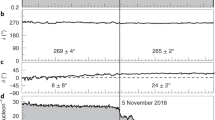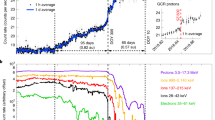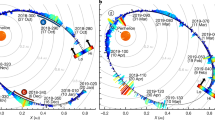Abstract
For more than five decades, the shape and interactions of the heliosphere with the local interstellar medium have been discussed in the context of two competing models, posited in 19611: a magnetosphere-like heliotail and a more symmetric bubble shape. Although past models broadly assumed the magnetosphere-like concept, the accurate heliospheric configuration remained largely undetermined due to lack of measurements. In recent years, however, Voyagers 1 and 2 (V1 and V2) crossed the termination shock — the boundary where the solar wind drops — north and south of the ecliptic plane at 94 au2,3 and 84 au4 in 2004 and 2007, respectively, and discovered the reservoir of ions and electrons that constitute the heliosheath, while Cassini remotely imaged the heliosphere5 for the first time in 2003. Here we report 5.2–55 keV energetic neutral atom (ENA) global images of the heliosphere obtained with the Cassini/Ion and Neutral Camera (INCA). We compare them with 28–53 keV ions measured within the heliosheath by the low-energy charged particle (LECP) experiment onboard V1 and V2 over an 11-year period (2003–2014). We show that the heliosheath ions are the source of ENA. These observations also demonstrate that the heliosphere responds promptly, within ~2–3 years, to outward propagating solar wind changes in both the nose and tail directions. These results, together with the V1 measurement of a ~0.5 nT interstellar magnetic field6 and the enhanced ratio between particle pressure and magnetic pressure in the heliosheath7, strongly suggest a diamagnetic bubble-like heliosphere with few substantial tail-like features. Our results are consistent with recent modelling8–11.
This is a preview of subscription content, access via your institution
Access options
Access Nature and 54 other Nature Portfolio journals
Get Nature+, our best-value online-access subscription
$29.99 / 30 days
cancel any time
Subscribe to this journal
Receive 12 digital issues and online access to articles
$119.00 per year
only $9.92 per issue
Buy this article
- Purchase on Springer Link
- Instant access to full article PDF
Prices may be subject to local taxes which are calculated during checkout



Similar content being viewed by others
References
Parker, E. N. The stellar-wind regions. Astrophys. J. 134, 20 (1961).
Decker, R. B . et al. Voyager 1 in the foreshock, termination shock, and heliosheath. Science 309, 2020–2024 (2005).
Stone, E. C . et al. Voyager 1 explores the termination shock region and the heliosheath beyond. Science 309, 2012–2020 (2005).
Decker, R. B. et al. Mediation of the solar wind termination shock by non-thermal ions. Nature 454, 67–70 (2008).
Krimigis, S. M., Mitchell, D. G., Roelof, E. C., Hsieh, K. C. & McComas, D. J. Imaging the interaction of the heliosphere with the interstellar medium from Saturn with Cassini. Science 326, 971–973 (2009).
Burlaga, L. F., Ness, N. F. & Stone, E. C. Magnetic field observations as Voyager 1 entered the heliosheath depletion region. Science 341, 147–150 (2013).
Krimigis, S. M., Mitchell, D. G., Roelof, E. C. & Decker, R. B. ENA (E>5 keV) images from Cassini and Voyager “ground truth”: suprathermal pressure in the heliosheath AIP Conf. Proc. 1302, 79 (2010).
Opher, M., Drake, J. F., Zieger, B. & Gombosi, T. I. Magnetized jets driven by the Sun: the structure of the heliosphere revisited. Astrophys. J. Lett. 800, 7 (2015).
Drake, J. F., Swisdak, M. & Opher, M. A model of the heliosphere with jets. Astrophys. J. Lett. 808, 6 (2015).
Kivelson, M. G. & Jia, X. An MHD model of Ganymede's mini-magnetosphere suggests that the heliosphere forms in a sub-Alfvénic flow. J. Geophys. Res. 118, 6839–6846 (2013).
Izmodenov, V. V. & Alexashov, D. B. Three-dimensional kinetic-MHD model of the global heliosphere with the heliopause-surface fitting. Astrophys. J. Suppl. S. 220, 14 (2015).
Dialynas, K., Krimigis, S. M., Mitchell, D. G., Roelof, E. C. & Decker, R. B. A three-coordinate system (ecliptic, galactic, ISMF) spectral analysis of heliospheric ENA emissions using Cassini/INCA measurements. Astrophys. J. 778, 13 (2013).
Dialynas, K ., Krimigis, S. M ., Mitchell, D. G ., Roelof, E. C & Decker, R. B. Energetic Neutral Atom (ENA) intensity gradients in the heliotail during year 2003, using Cassini/INCA measurements. J. Phys. Conf. Ser. 577, 012007 (2015).
McComas, D. J. et al. Global observations of the interstellar interaction from the Interstellar Boundary Explorer (IBEX). Science 326, 959 (2009).
Dayeh, M. A. et al. Spectral properties of regions and structures in the Interstellar Boundary Explorer (IBEX) sky maps. Astrophys. J. 734, 29 (2011).
Reisenfeld, D. et al. Tracking the solar cycle through IBEX observations of energetic neutral atom flux variations at the heliospheric poles. Astrophys. J. 833, 2 (2016).
Schwadron, N. et al. Separation of the Interstellar Boundary Explorer ribbon from the globally distributed Energetic Neutral Atom flux. Astrophys. J. 731, 22 (2011).
Sokół, J. M., Swaczyna, P., Bzowski, M. & Tokumaru, M. Reconstruction of helio-latitudinal structure of the solar wind proton speed and density. Solar Phys. 290, 2589–2615 (2015).
McComas, D. J. et al. Weakest solar wind of the space age and the current “mini” solar maximum. Astrophys. J. 779, 10 (2013).
Krimigis, S. M., Roelof, E. C., Decker, R. B. & Hill, M. E. Zero outward flow velocity for plasma in a heliosheath transition layer. Nature 474, 359–361 (2011).
McComas, D. J., Dayeh, M. A., Funsten, H. O., Livadiotis, G. & Schwadron, N. A. The heliotail revealed by the Interstellar Boundary Explorer. Astrophys. J. 771, 77 (2013).
Livadiotis, G., McComas, D. J., Dayeh, M. A., Funsten, H. O. & Schwadron, N. A. First sky map of the inner heliosheath temperature using IBEX spectra. Astrophys. J. 734, 19 (2011).
Zhang, J, Woch, J., Solanki, S. K. & Steiger, R. The Sun at solar minimum: north–south asymmetry of the polar coronal holes. Geophys. Res. Lett. 29, 1236 (2002).
Opher, M., Stone, E. C., Liewer, P. C. & Gombosi, T. Global asymmetry of the heliosphere. Phys. Inner Heliosheath 858, 45–50 (2006).
Roelof, E. C ., Krimigis, S. M ., Mitchell, D. G ., Decker, R. B & Dialynas, K. Cassini ENA images of the heliosheath and Voyager “ground truth”: thickness of the heliosheath. AIP Conf. Proc. 1436, 239 (2012).
Heerikhuisen, J., Zirnstein, E. J., Funsten, H. O., Pogorelov, N. V. & Zank, G. P. The effect of new interstellar medium parameters on the heliosphere and energetic neutral atoms from the interstellar boundary. Astrophys. J. 784, 73 (2014).
Burlaga, L. F. & Ness, N. F. Interstellar magnetic fields observed by Voyager 1 beyond the heliopause. Astrophys. J. Lett. 795, 5 (2014).
Opher, M. et al. A strong, highly-tilted interstellar magnetic field near the Solar System. Nature 462, 7276 (2009).
Gurnett, D. A., Kurth, W. S., Burlaga, L. F. & Ness, N. F. In situ observations of interstellar plasma with Voyager 1. Science 341, 1489–1492 (2013).
Wood, B. E., Izmodenov, V. V., Alexashov, D. B., Redfield, S. & Edelman, E. A new detection of LYα absorption from the heliotail. Astrophys. J. 780, 12 (2014).
Galli, A. et al. The roll-over of heliospheric neutral hydrogen bellow 100 eV: observations and implications. Astrophys. J. 821, 10 (2016).
McComas, D. J. et al. The heliosphere’s interstellar interaction: no bow shock. Science 336, 1291 (2012).
Zieger, B., Opher, M., Schwadron, N. A., McComas, D. J. & Tóth, G. A slow bow shock ahead of the heliosphere. Geophys. Res. Lett. 40, 12 (2013).
Fahr, H. J. Is the heliospheric interface submagnetosonic? Consequences for the LISM presence in the heliosphere. Adv. Space. Res. 6, 13– 25 (1986).
Opher, M., Stone, E. C. & Gombosi, T. I. The orientation of the local interstellar magnetic field. Science 316, 875–878 (2007).
Krimigis, S. M . et al. Search for the exit: Voyager 1 at heliosphere’s border with the Galaxy. Science 341, 144–147 (2013).
Krimigis, S. M. et al. Magnetosphere Imaging Instrument (MIMI) on the Cassini mission to Saturn/Titan. Space Sci. Rev. 114, 233 (2004).
Krimigis, S. M., Sergis, S., Mitchell, D. G., Hamilton, D. C. & Krupp, N. A dynamic, rotating ring current around Saturn. Nature 450, 1050–1053 (2007).
Markwardt, C. B. Non-linear least squares fitting in IDL with MPFIT. In Proc. Astronomical Data Analysis Software and Systems XVIII (eds Bohlender, D., Dowler, P. & Durand, D.) 251–254 (ASP Conf. Series 411, 2009).
Levenberg, K. A method for the solution of certain nonlinear problems in least squares. Quart. Appl. Math. 2, 164–168 (1944).
Marquardt, D. W. An algorithm for least squares estimation of nonlinear parameters. SIAM J. Appl. Math. 11, 431–441 (1963).
Lindsay, B. G. & Stebbings, R. F. Charge transfer cross sections for energetic neutral atom data analysis. J. Geophys. Res. 110, A12213 (2005).
Burlaga, L. F. et al. Crossing the termination shock into the heliosheath: magnetic fields. Science 309, 2020–2024 (2005).
Katushkina, O. A., Izmodenov, V. V., Quemerais, E. & Sokół, J. M. Heliolatitudinal and time variations of the solar wind mass flux: inferences from the backscattered solar Lyman-alpha intensity maps. J. Geophys. Res. 118, 2800–2808 (2013).
Fahr, H.-J., Fichtner, H. & Scherer, K. Theoretical aspects of energetic neutral atoms as messengers from distant plasma sites with emphasis on the heliosphere. Rev. Geophys. 45, 4 (2007).
Katushkina, O. A. & Izmodenov, V. V. Effect of the heliospheric interface on the distribution of interstellar hydrogen atom inside the heliosphere. Astron. Lett. 36, 297–330 (2010).
Decker, R. B., Krimigis, S. M., Roelof, E. C. & Hill, M. E. No meridional plasma flow in the heliosheath transition region. Nature 489, 124–127 (2012).
Richardson, J. D., Wang, C. & Paularena, K. I. The solar wind: from solar minimum to solar maximum. Adv. Space Res. 27, 471–479 (2001).
Acknowledgements
This work was supported at JHU/APL by NASA under contract NAS5 97271 and NNX07AJ69G and by subcontract at the Office for Space Research and Technology. The authors are grateful to M. Kusterer for software development and assistance with the INCA data processing and Dogfish graphic designers (http://www.dogfish.gr/en/) for assistance with graphics in Fig. 1a.
Author information
Authors and Affiliations
Contributions
All authors were actively involved in all aspects of this manuscript. K.D. contributed most of the text and carried out most of the data analysis; S.M.K., D.G.M. and E.C.R. contributed to the text and provided most of the theory and interpretations; R.B.D. and S.M.K. performed the Voyager ion data analysis; D.G.M. oversaw the Cassini/INCA data.
Corresponding author
Ethics declarations
Competing interests
The authors declare no competing financial interests.
Supplementary information
Supplementary Information
Supplementary Table 1, Supplementary Figures 1–3 and Supplementary References. (PDF 756 kb)
Rights and permissions
About this article
Cite this article
Dialynas, K., Krimigis, S., Mitchell, D. et al. The bubble-like shape of the heliosphere observed by Voyager and Cassini. Nat Astron 1, 0115 (2017). https://doi.org/10.1038/s41550-017-0115
Received:
Accepted:
Published:
DOI: https://doi.org/10.1038/s41550-017-0115
This article is cited by
-
Gravity assist space pruning and global optimization of spacecraft trajectories for solar system boundary exploration
Complex & Intelligent Systems (2023)
-
Future Exploration of the Outer Heliosphere and Very Local Interstellar Medium by Interstellar Probe
Space Science Reviews (2023)
-
The Structure of the Global Heliosphere as Seen by In-Situ Ions from the Voyagers and Remotely Sensed ENAs from Cassini
Space Science Reviews (2022)
-
In Situ Observations of Interstellar Pickup Ions from 1 au to the Outer Heliosphere
Space Science Reviews (2022)
-
The Early History of Heliospheric Science and the Spacecraft That Made It Possible
Space Science Reviews (2022)



